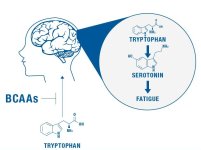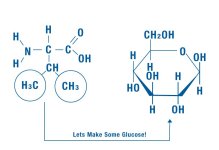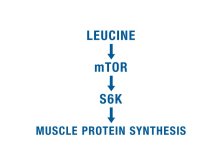Should I Add BCAAs to My Supplement Stack?
Are BCAAs an essential part of your supplementation plan? Or is it all just marketing hype? See what the research says and decide for yourself!
Branched chain amino acids (BCAAs) are essential amino acids (meaning our body does not create them) that contain an aliphatic (branched) side-chain.
There are three BCAAs: Leucine, Isoleucine, and Valine. These amino acids are key players in the regulation of muscle mass and must be consumed through your diet.
One interesting aspect of BCAAs is their metabolism in the human body. The breakdown of BCAAs is regulated through an enzyme complex known as the branched chain amino acid dehydrogenase complex, which we are going to shorten to something more manageable and call it BDC.
To take biochemistry from test tube to muscles, this means that when we have higher levels of BDC around, more BCAAs are broken down.
Levels of BDC in the human body are increased when we exercise, indicating that exercise promotes breakdown of BCAAs.
Another important aspect of this complex (which we will discuss later in this article) is that when the metabolites of BCAAs are present (i.e. the products of the breakdown), they inhibit the BDC complex. Which means if you have a lot of BCAA breakdown products around you preserve the currently available amino acids.
The Anti-Fatigue Hypothesis: Battling Tryptophan
Before we dive into the individual BCAAs and their functions, we need to cover one aspect of the collective group of BCAAs, their proposed ability to reduce fatigue.
There is a hypothesis about fatigue during training, it is called the central hypothesis of fatigue.
The Central Hypothesis of Fatigue states that elevated levels of serotonin in the brain caused by increased levels of tryptophan (tryptophan is converted to serotonin) during exercise induces fatigue.
BCAAs are thought to prevent this because they compete for the same transporter into the brain. So the hypothesis is that if you increase your BCAAs in the blood by supplementation, you prevent tryptophan uptake and thus reduce fatigue.
Now this sounds great as a biochemical and physiological theory. . . but unfortunately the research hasn’t created any promising results and any anti-fatigue effects of BCAAs by reducing “Central Fatigue” appear to be minimal if any.
Valine: Glucose Creation
Valine is the least researched or well understood of the 3 BCAAs, and as such the currently known biological effects of it are minimal.
Valine is a glucogenic amino acid, meaning it can create and/or be converted into glucose1,2. The methyl carbons of valine can be utilized to produce glucose and ultimately glycogen.
This process of valine oxidation for glucose is increased in skeletal muscle following injury, which suggests that consuming extra valine in times of muscle injury (i.e. heavy training) might be beneficial for muscle recovery. Unfortunately for valine, it is far less effective at this than Leucine (a theme that repeats itself).
Leucine: The King of BCAAs?
The main reason people use BCAAs is to optimize muscle building, and in the land of BCAAs, leucine is the king of promoting muscle protein synthesis.
When we think of the science behind muscle protein synthesis we think of two proteins, mTOR and S6K.
Interestingly, leucine is able to activate the mTOR pathway independently of other growth signals, like insulin.
Leucine and Muscle Protein Synthesis
Leucine is a major contributor to the anabolic capabilities of protein supplementation by activating mTOR. For example, 5g of leucine elicits a greater muscle protein synthesis signal than 5g of a mixture of BCAAs.
There is even evidence that leucine provides the most potent growth signal when you compare leucine to other amino acids and even insulin!
Do you get it yet? Leucine is probably pretty important for muscle protein synthesis.
Leucine and Insulin: Dyanmic Duo
Just in case you don’t really care about growing muscle (which if you don’t, I am sorry for your loss), leucine might also help with recovery.
One of the critical components of recovery is how quickly you can replenish your glycogen stores. For hard-charging athletes the mantra is “the faster the better”. The quicker one can reload their glycogen stores, the faster they are able to recover. Leucine can actually speed up the recovery process by increasing glucose uptake. It does this with a nifty little trick.
Leucine signals for insulin to be release from the pancreas without the presence of carbohydrate. Working in conjunction with insulin, leucine can actually have a positive two-fold effect on glucose uptake into muscle cells.
Combining leucine supplementation with post-workout carbohydrate has been shown to be incredibly effective in restoring muscle glycogen, more so than amino acid or carbohydrate supplementation alone. Interestingly enough, insulin also works synergistically to control muscle protein synthesis in response to diet and training. When it comes down to recovery and muscle growth, leucine is critical for optimizing both!
One other interesting aspect of the leucine/glucose story is that leucine appears to regulate itself. Meaning that once it gets to a certain point it shuts off the glucose uptake signal. . . I love feedback loops.
Leucine for Fasted Training
Smart leucine supplementation may be able to help improve and even optimize an anabolic environment while still allowing the fat oxidation benefits of training fasted. Research studies have shown that consuming leucine pre-workout can reduce exercise induced cortisol and protein degradation.
If you are training fasted, it appears that pre-workout leucine supplementation is probably a smart idea. Yes, I understand this means you are not truly training fasted, but who cares about semantics, you have muscle to build!
Leucine and Fat Oxidation
There is a saying amongst exercise enthusiasts that fat burns in a flame of carbohydrate. Well, that is like saying biceps curls are the only thing that builds biceps. Just like rows and chins can build your guns, fat also burns in a flame of amino acids, not just carbohydrates. Without getting too technical, the carbon backbone of amino acids provides substrates to fuel the Citric Acid cycle (aka fat oxidation).
Specifically, leucine is converted into Acetyl CoA, the major substrate that “spins” the cycle. In fact, when you are low on carbohydrate your body will actually use a significant amount of amino acids to fuel fat oxidation.
Leucine supplementation provides the necessary ingredients to fuel the citric acid cycle and facilitate fat oxidation. Don’t believe me? Read the research. Giving chronically active men 2.25g/day of leucine decreased their respiratory quotient when compared to placebo, indicating they were using more fat for fuel3.
Another study showed that leucine promotes energy partitioning from fat cells to muscle cells4, decreasing energy storage and increasing fatty acid utilization in muscle.
IsoLeucine
Isoleucine is an isomer (fancy word meaning chemically identical but structurally different) of leucine. And like most little brothers, it is out shadowed by leucine in terms of its benefit. Now that being said, it does have some interesting properties we should discuss.
Isoleucine: The Muscle Glucose Filler
Much like leucine, isoleucine can promote glucose uptake into skeletal muscle, indicating it can be beneficial for recovery. In fact, this appears to be a decent size of effect as well with some studies showing a 35%-70% increase in glucose uptake in muscle tissue5,6.
Isoleucine: No love for glycogen synthesis
Sadly, the isoleucine induced increase in glucose uptake does not result in improved glycogen synthesis. So isoleucine pales in comparison to its brother leucine… but do not despair, because as we mentioned leucine can improved glycogen resynthesis so if you take leucine and isoleucine together you may get a synergistic effect!
BCAA Metabolites: Enter HMB
Remember way back up at the top were we mentioned that the breakdown products of BCAAs can inhibit the BDC complex and slow the breakdown of available BCAAs? Well someone decided it might be effective to just introduce those metabolites themselves into the system and stop the breakdown.
This brings us to β-Hydroxy β-Methylbutyrate (aka HMB). HMB is a metabolite of leucine and has actually been shown to prevent the breakdown of muscle tissue.
Without going too far down the research study rabbit hole, there is ample evidence to show that HMB can reduce markers of muscle injury, aid in recovery, and has anti-catabolic effects. Essentially, HMB is effective at reducing muscle-tissue breakdown at around 3g/day7.
Key Takeaways
Are BCAAs an essential part of your supplementation plan? Or is it all just marketing hype? See what the research says and decide for yourself!
Branched chain amino acids (BCAAs) are essential amino acids (meaning our body does not create them) that contain an aliphatic (branched) side-chain.
There are three BCAAs: Leucine, Isoleucine, and Valine. These amino acids are key players in the regulation of muscle mass and must be consumed through your diet.
One interesting aspect of BCAAs is their metabolism in the human body. The breakdown of BCAAs is regulated through an enzyme complex known as the branched chain amino acid dehydrogenase complex, which we are going to shorten to something more manageable and call it BDC.
To take biochemistry from test tube to muscles, this means that when we have higher levels of BDC around, more BCAAs are broken down.
Levels of BDC in the human body are increased when we exercise, indicating that exercise promotes breakdown of BCAAs.
Another important aspect of this complex (which we will discuss later in this article) is that when the metabolites of BCAAs are present (i.e. the products of the breakdown), they inhibit the BDC complex. Which means if you have a lot of BCAA breakdown products around you preserve the currently available amino acids.
The Anti-Fatigue Hypothesis: Battling Tryptophan
Before we dive into the individual BCAAs and their functions, we need to cover one aspect of the collective group of BCAAs, their proposed ability to reduce fatigue.
There is a hypothesis about fatigue during training, it is called the central hypothesis of fatigue.
The Central Hypothesis of Fatigue states that elevated levels of serotonin in the brain caused by increased levels of tryptophan (tryptophan is converted to serotonin) during exercise induces fatigue.
BCAAs are thought to prevent this because they compete for the same transporter into the brain. So the hypothesis is that if you increase your BCAAs in the blood by supplementation, you prevent tryptophan uptake and thus reduce fatigue.
Now this sounds great as a biochemical and physiological theory. . . but unfortunately the research hasn’t created any promising results and any anti-fatigue effects of BCAAs by reducing “Central Fatigue” appear to be minimal if any.
Valine: Glucose Creation
Valine is the least researched or well understood of the 3 BCAAs, and as such the currently known biological effects of it are minimal.
Valine is a glucogenic amino acid, meaning it can create and/or be converted into glucose1,2. The methyl carbons of valine can be utilized to produce glucose and ultimately glycogen.
This process of valine oxidation for glucose is increased in skeletal muscle following injury, which suggests that consuming extra valine in times of muscle injury (i.e. heavy training) might be beneficial for muscle recovery. Unfortunately for valine, it is far less effective at this than Leucine (a theme that repeats itself).
Leucine: The King of BCAAs?
The main reason people use BCAAs is to optimize muscle building, and in the land of BCAAs, leucine is the king of promoting muscle protein synthesis.
When we think of the science behind muscle protein synthesis we think of two proteins, mTOR and S6K.
Interestingly, leucine is able to activate the mTOR pathway independently of other growth signals, like insulin.
Leucine and Muscle Protein Synthesis
Leucine is a major contributor to the anabolic capabilities of protein supplementation by activating mTOR. For example, 5g of leucine elicits a greater muscle protein synthesis signal than 5g of a mixture of BCAAs.
There is even evidence that leucine provides the most potent growth signal when you compare leucine to other amino acids and even insulin!
Do you get it yet? Leucine is probably pretty important for muscle protein synthesis.
Leucine and Insulin: Dyanmic Duo
Just in case you don’t really care about growing muscle (which if you don’t, I am sorry for your loss), leucine might also help with recovery.
One of the critical components of recovery is how quickly you can replenish your glycogen stores. For hard-charging athletes the mantra is “the faster the better”. The quicker one can reload their glycogen stores, the faster they are able to recover. Leucine can actually speed up the recovery process by increasing glucose uptake. It does this with a nifty little trick.
Leucine signals for insulin to be release from the pancreas without the presence of carbohydrate. Working in conjunction with insulin, leucine can actually have a positive two-fold effect on glucose uptake into muscle cells.
Combining leucine supplementation with post-workout carbohydrate has been shown to be incredibly effective in restoring muscle glycogen, more so than amino acid or carbohydrate supplementation alone. Interestingly enough, insulin also works synergistically to control muscle protein synthesis in response to diet and training. When it comes down to recovery and muscle growth, leucine is critical for optimizing both!
One other interesting aspect of the leucine/glucose story is that leucine appears to regulate itself. Meaning that once it gets to a certain point it shuts off the glucose uptake signal. . . I love feedback loops.
Leucine for Fasted Training
Smart leucine supplementation may be able to help improve and even optimize an anabolic environment while still allowing the fat oxidation benefits of training fasted. Research studies have shown that consuming leucine pre-workout can reduce exercise induced cortisol and protein degradation.
If you are training fasted, it appears that pre-workout leucine supplementation is probably a smart idea. Yes, I understand this means you are not truly training fasted, but who cares about semantics, you have muscle to build!
Leucine and Fat Oxidation
There is a saying amongst exercise enthusiasts that fat burns in a flame of carbohydrate. Well, that is like saying biceps curls are the only thing that builds biceps. Just like rows and chins can build your guns, fat also burns in a flame of amino acids, not just carbohydrates. Without getting too technical, the carbon backbone of amino acids provides substrates to fuel the Citric Acid cycle (aka fat oxidation).
Specifically, leucine is converted into Acetyl CoA, the major substrate that “spins” the cycle. In fact, when you are low on carbohydrate your body will actually use a significant amount of amino acids to fuel fat oxidation.
Leucine supplementation provides the necessary ingredients to fuel the citric acid cycle and facilitate fat oxidation. Don’t believe me? Read the research. Giving chronically active men 2.25g/day of leucine decreased their respiratory quotient when compared to placebo, indicating they were using more fat for fuel3.
Another study showed that leucine promotes energy partitioning from fat cells to muscle cells4, decreasing energy storage and increasing fatty acid utilization in muscle.
IsoLeucine
Isoleucine is an isomer (fancy word meaning chemically identical but structurally different) of leucine. And like most little brothers, it is out shadowed by leucine in terms of its benefit. Now that being said, it does have some interesting properties we should discuss.
Isoleucine: The Muscle Glucose Filler
Much like leucine, isoleucine can promote glucose uptake into skeletal muscle, indicating it can be beneficial for recovery. In fact, this appears to be a decent size of effect as well with some studies showing a 35%-70% increase in glucose uptake in muscle tissue5,6.
Isoleucine: No love for glycogen synthesis
Sadly, the isoleucine induced increase in glucose uptake does not result in improved glycogen synthesis. So isoleucine pales in comparison to its brother leucine… but do not despair, because as we mentioned leucine can improved glycogen resynthesis so if you take leucine and isoleucine together you may get a synergistic effect!
BCAA Metabolites: Enter HMB
Remember way back up at the top were we mentioned that the breakdown products of BCAAs can inhibit the BDC complex and slow the breakdown of available BCAAs? Well someone decided it might be effective to just introduce those metabolites themselves into the system and stop the breakdown.
This brings us to β-Hydroxy β-Methylbutyrate (aka HMB). HMB is a metabolite of leucine and has actually been shown to prevent the breakdown of muscle tissue.
Without going too far down the research study rabbit hole, there is ample evidence to show that HMB can reduce markers of muscle injury, aid in recovery, and has anti-catabolic effects. Essentially, HMB is effective at reducing muscle-tissue breakdown at around 3g/day7.
Key Takeaways
- BCAAs have some interesting properties that support their use in athletes and in sedentary people alike with most of the benefit coming from Leucine.
- Supplementing with Leucine and HMB may convey some benefit to your recovery.
- If you go with a BCAA try to get something with at least 5G of leucine in it.
- References:
- The conversion of D-valine to glycogen in the rat.
- The conversion of L-valine to glucose and glycogen in the rat.
- The effects of leucine on fatty acid oxidation in chronically active males
- Leucine and calcium regulate fat metabolism and energy partitioning in murine adipocytes and muscle cells.
- Isoleucine, a potent plasma glucose-lowering amino acid, stimulates glucose uptake in C2C12 myotubes.
- Isoleucine, a blood glucose-lowering amino acid, increases glucose uptake in rat skeletal muscle in the absence of increases in AMP-activated protein kinase activity.
- Effects of leucine and its metabolite β-hydroxy-β-methylbutyrate on human skeletal muscle protein metabolism.



